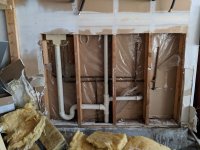My laundry room backs up to my garage, which is not heated. For the past 2 years we've lived here, the pipes have frozen but not burst. I tore out the drywall in the garage (image attached) away this winter because the pipes were frozen for over a week and we needed to do laundry and I used a hairdryer to warm the pipes up until water was flowing again. While the one week without laundry was inconvenient, the main thing I want to do is to avoid a burst pipe. I've installed shutoffs in the basement so that if I know we're in for really cold weather I can shut them off, but that requires me to be thinking about temps and frozen pipes...
I was thinking when I pulled the drywall back I could figure out a way to run pex from a location in my basement to this location to lessen the risk of burst pipes, but I don't think this is going to be possible without a lot of work.
Does anyone have any suggestions for my situation? Burying an electrical / heat tape kind of device in the wall doesn't seem right. The only other thing I can think of is scabbing on an additional 2x4 wall in the garage to add an extra layer of insulation and possibly opening channels in the wall inside of the laundry room to let some of the warmer air in that room into the stud bays to help keep the pipes above freezing (but there isn't much air circulation behind the cabinets/appliances, so don't think that will help much).
I was thinking when I pulled the drywall back I could figure out a way to run pex from a location in my basement to this location to lessen the risk of burst pipes, but I don't think this is going to be possible without a lot of work.
Does anyone have any suggestions for my situation? Burying an electrical / heat tape kind of device in the wall doesn't seem right. The only other thing I can think of is scabbing on an additional 2x4 wall in the garage to add an extra layer of insulation and possibly opening channels in the wall inside of the laundry room to let some of the warmer air in that room into the stud bays to help keep the pipes above freezing (but there isn't much air circulation behind the cabinets/appliances, so don't think that will help much).

